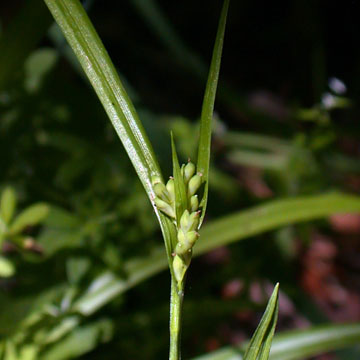

Carex blanda - (image 1 of 6)
Taxonomy
Family: Cyperaceae
Section Laxiflorae
Habitat
Open meadows, disturbed mesic prairies, ditches, shaded parks and dry to mesic woods. Considered to be rather weedy.
Associates
Distribution
ME and southern Quebec west to ND, south to GA, northwest FL and TX.
Morphology
Stems tufted, to 60 cm; fertile stems slightly winged, minutely serrulate above; basal sheaths more or less brown; leaves to 1 cm wide, narrower on fertile shoots; angles of the lowest bracteal sheaths serrulate; terminal spike staminate, 1-2 cm, on a shorter to elongate peduncle, often exceeded by the uppermost bract; pistillate spikes 3-4, 1.5-2 cm long; pistillate scales cuspidate or short-awned; perigynia 4-18 per spike, crowded and overlapping, 2.5-4 mm long, 2-ribbed with many fine nerves, obtusely trigonous, obovoid, with a short, abruptly bent beak; achene obtusely trigonous.
Notes
Fruiting May to June
Wetland indicator: FAC
The specific epithet blanda means "charming". Similar but less common species include C. laxiflora and C. hitchcockiana. Carex laxiflora is more typical of mesophytic forests and is smooth on the angles of the bracteal sheaths. Carex hitchcockiana occurs in mesic woods and can be distinguished by its minutely pubescent sheaths.
References
Curtis, L. 2006. Woodland Carex of the upper Midwest. Lake Villa, IL.
Gleason, Henry A. and A. Cronquist. 1991. Manual of Vascular Plants of
Northeastern United States and Adjacent Canada. Second Ed.
The New York Botanical Garden. Bronx, NY
Swink, F. and G. Wilhelm. 1994. Plants of the Chicago Region.
Indiana Academy of Science. The Morton Arboretum. Lisle, Illinois.
|
© Michael Hough 2010 |